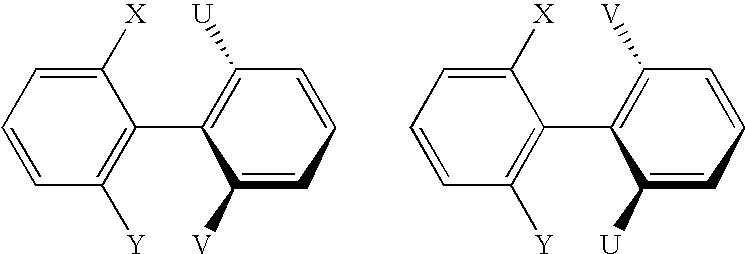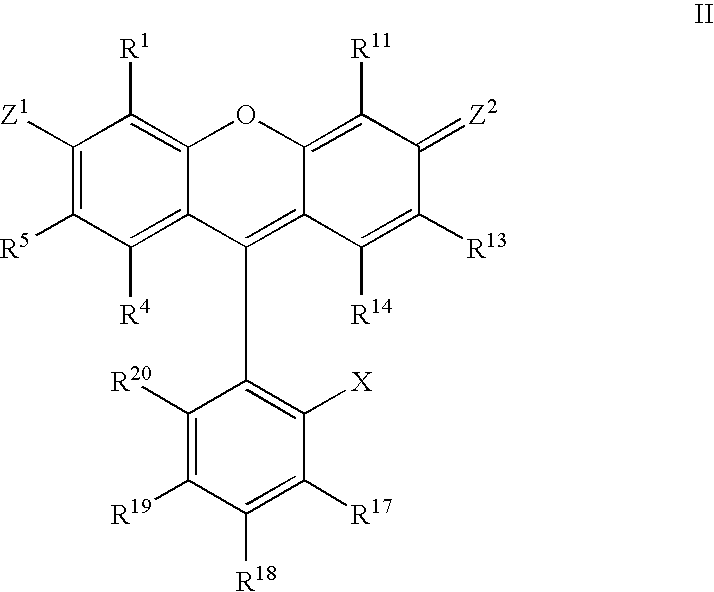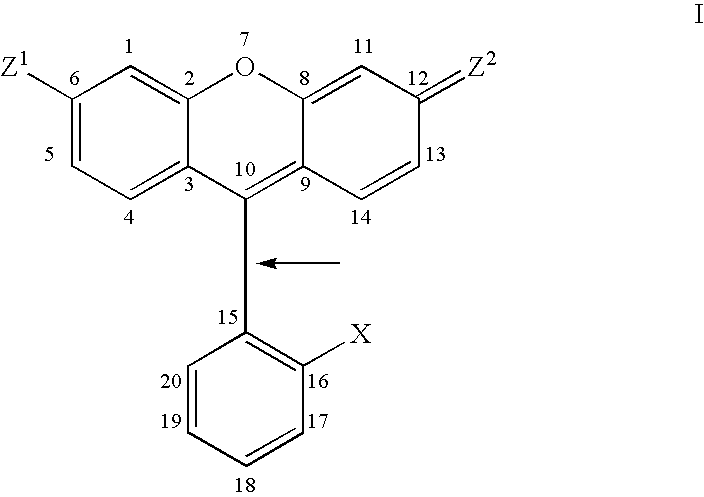Atropisomers of asymmetric xanthene fluorescent dyes and methods of DNA sequencing and fragment analysis
- Summary
- Abstract
- Description
- Claims
- Application Information
AI Technical Summary
Benefits of technology
Problems solved by technology
Method used
Image
Examples
example 1
Preparation of Menthyl Carbamate Diastereomers of C-1 Aminomethyl, C-19 Carboxy Fluorescein, 1a and 1b.
[0174] The hydrochloride salt of C-1 aminomethyl, C-19 carboxy fluorescein (5.16 gm, 11.6 mMol, 441.8 MW; Shipchandler (1987) Anal. Biochem. 162:89-101) was dissolved in 50 ml of deionized formamide and 10.2 ml diisopropylethylamine. (-) Menthyl chloroformate (3.06 gm, 3.0 ml, 14 mMol, 219 MW; Aldrich Chemical, Milwaukee, Wis.; Jour. Chem. Soc., Chem. Commun. (1987) 470; Yodo (1988) Chem. Pharm. Bull. 36:902) was added dropwise with stirring at room temperature under argon. After 1.5 hours, TLC analysis (ethyl acetate / hexane:4 / 1) showed partial conversion of reactant to a higher Rf spot. Another 1 ml (-) Menthyl chloroformate was added and stirring was continued for another 0.5 hour. TLC analysis showed complete conversion to the higher Rf product. Dilution of the reaction mixture with saturated aqueous NaHCO.sub.3 was followed by extraction with 500 ml ethyl acetate. The aqueous f...
example 2
Separation and Isolation of Diastereomers 1a and 1b by HPLC
[0175] Crude diastereomers 1a and 1b were separated and purified by a two stage chromatography process on an open column, flash reverse phase column rough separation, followed by preparative reverse phase HPLC.
[0176] The mixture of 1a and 1b was dissolved in ethyl acetate and adsorbed on C-1 8 reverse phase silica gel. The solvent was removed under vacuum and the solid was loaded on the top of a pre-equilibrated C-18 reverse phase column (21 cm length.times.6 cm diameter). The diastereomers were separated and eluted with 25% CH.sub.3CN in 100 mM TEAA (triethylammonium acetate) by collecting fractions. The fractions were analyzed by analytical reverse phase HPLC on a C-18 column (Metachem ODS3, 25 cm length.times.4.6 mm inner diameter) with a linear gradient of 25% to 35% CH.sub.3CN in 100 mM TEAA from 0 to 30 minutes at 1.0 ml / min flow rate and 260 nm UV detection. The fractions that contained the first eluting diastereomer ...
example 3
Synthesis of Atropisomer Amine 2a
[0179] Diastereomer 1a (1.1 gm, 1.87 mmoles, 587.6 MW) was dissolved in 100 ml water and cooled to 0.degree. C. Concentrated sulfuric acid (15 ml) was added dropwise to give a brownish solution (FIG. 2a). The temperature was allowed to rise to room temperature and the mixture was stirred overnight. The mixture was added slowly to 1.5 ml of ice water and then adsorbed on pre-equilibrated C-18 silica gel (4 cm length.times.3 cm diameter). The support was washed with water until the pH of the eluent was neutral. The crude product was eluted with 200 ml CH.sub.3OH which was concentrated under vacuum and dried to yield atropisomer 2a C-1 aminomethyl, C-19 carboxy fluorescein sulfate salt as an orange solid (0.93 gm, 95% yield, 503.4 MW). .sup.1H NMR (methanol-d4) .delta. 8.43, 1H, d; 8.34, 1H, d; 7.92, 1H, s; 7.23, 3H, m; 7.06, 1H, d; 6.98, 1H, d; 4.58, 2H, s.
[0180] The enantiomeric purity of hydrolyzed and purified 2a was analyzed by chiral column HPLC (...
PUM
 Login to View More
Login to View More Abstract
Description
Claims
Application Information
 Login to View More
Login to View More - R&D
- Intellectual Property
- Life Sciences
- Materials
- Tech Scout
- Unparalleled Data Quality
- Higher Quality Content
- 60% Fewer Hallucinations
Browse by: Latest US Patents, China's latest patents, Technical Efficacy Thesaurus, Application Domain, Technology Topic, Popular Technical Reports.
© 2025 PatSnap. All rights reserved.Legal|Privacy policy|Modern Slavery Act Transparency Statement|Sitemap|About US| Contact US: help@patsnap.com



